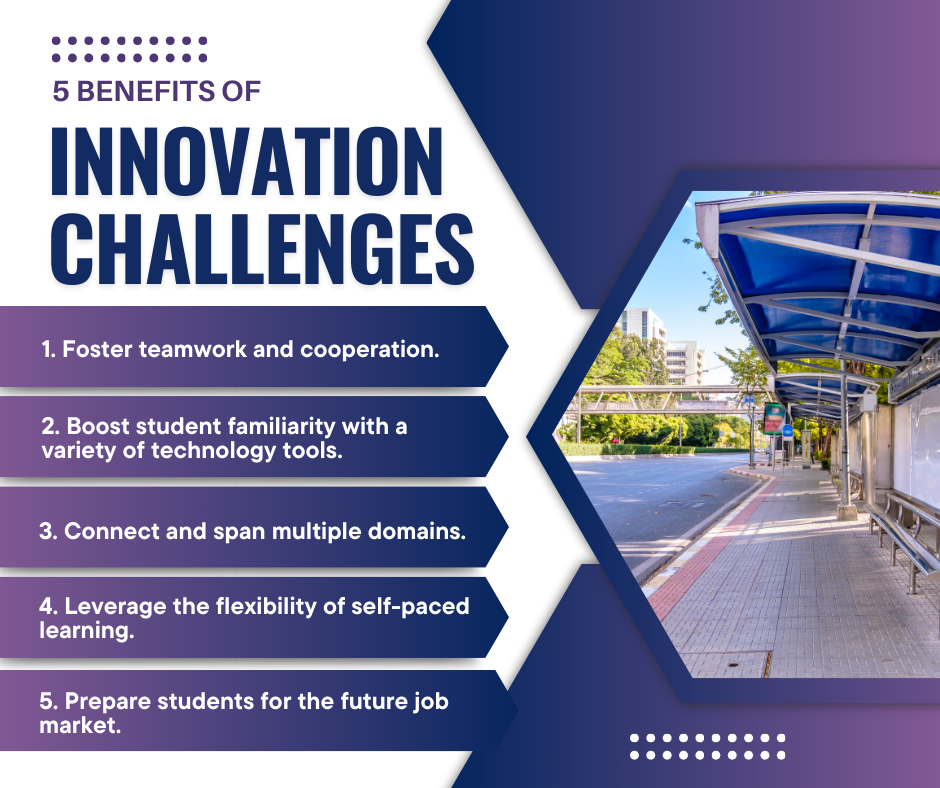In our ever-evolving world, education must adapt to prepare students for the challenges and opportunities of the future. One effective approach to that challenge is blended learning, a combination of traditional classroom instruction and technology-based learning. When integrated with the principles of STEAM (Science, Technology, Engineering, Arts, and Mathematics), it creates an enriched educational experience. Student innovation challenges provide the perfect combination for student success.
How Blended Learning Benefits Students
Blended learning offers a number of advantages over traditional classroom instruction.
- It allows students to learn at their own pace.
- It provides them with more opportunities for hands-on learning.
- It gives them access to a wider range of resources.
STEAM education complements blended learning by helping students develop critical thinking and problem-solving skills. An example of the combination of STEAM education and blended learning is the “innovation challenge.”
What Are Innovation Challenges?
Student innovation challenges offer a platform for the development of holistic skills. Students gain a deeper understanding of core subjects where, often, traditional methods of instruction cannot effectively teach these skills. STEAM education encourages students to approach challenges from multiple perspectives, fostering a well-rounded skill set.
Innovation challenges enable students to apply theoretical concepts to real-world problems and give them the ability to adapt and innovate in various scenarios. Student engagement often suffers in traditional classroom settings. However, adding student innovation challenges to blended learning promotes active learning.
The Region 4 Innovation Challenge
In light of this, Texas’s Region 4 Education Service Center (@R4DigiLearn) has teamed up with industry and academic entities to develop a high school innovation challenge for students in grades 9–12. Region 4 is partnering with Houston Metro and the University of Houston’s Technology and Innovation Bridge to bring a real-world challenge to students — creating the bus shelter of the future.

The challenge is to develop and innovate a new type of bus shelter. Teachers will act as facilitators to help teams (2–5 students) use design and engineering principles to develop the bus shelter of the future. This real-world challenge is an opportunity for students to use design thinking and an engineering design process to solve the problem. Eight teams of students will compete to present their ideas and innovations to a board of experts at Metro.
Students will become active participants in their education, taking charge of their learning journey. The innovation challenge requires hands-on involvement, where students research, design, and create solutions. This engagement will deepen their understanding and instill a sense of ownership and excitement about their learning process.

It also will bridge the gap between theoretical knowledge and practical application. This connection to a real-world challenge will cultivate a sense of purpose as students see the direct impact of their ideas and solutions. Whether they are designing sustainable energy solutions or creating innovative bus shelters, students will understand how their efforts can contribute to the betterment of society.
The Benefits of Innovation Challenges
Foster teamwork and cooperation.
Innovation challenges often require collaboration among students with diverse skill sets. This blended learning environment fosters interdisciplinary teamwork and mirrors real-world work dynamics. Students from different backgrounds give unique perspectives, leading to richer solutions. This collaborative approach not only enhances students’ ability to work in teams but also exposes them to the importance of diverse viewpoints in driving innovation.
Boost student familiarity with a variety of technology tools.
The modern world is driven by technology, and blending learning with innovation challenges prepares students for this technology-rich environment. By integrating online platforms, simulations, and tools into their learning process, students become comfortable with various technological tools. This familiarity not only aids their learning but helps them to be marketable.
Connect and span multiple domains.
Blended learning offers the flexibility to integrate creative teaching methods, empowering educators to inspire students’ imaginations. The freedom to explore ideas, experiment with solutions, and think outside the box nurtures creativity. Students learn that innovation is not limited to a specific domain but can be applied across disciplines to develop groundbreaking solutions. This challenge will allow facilitators and students to use blended learning while simultaneously helping students learn to ideate and utilize people-first, empathetic research to better understand the challenge at hand.
Leverage the flexibility of self-paced learning.
One advantage of blended learning is the ability to accommodate different learning paces. Students have the opportunity to grasp concepts at their own speed, promoting a deeper understanding. This aspect is particularly beneficial in innovation challenges, where students may require additional time to research and experiment. Self-paced learning reduces the pressure of rigid deadlines, fostering a positive learning experience.
Prepare students for the future job market.
The skills acquired through this approach align with the demands of a rapidly evolving job market. Student innovation challenges prepare students for the careers of tomorrow. Students develop adaptability, resilience, and a proactive attitude—qualities sought after by employers. Additionally, the practical experience gained from innovation challenges can be a valuable addition to their résumés, setting them apart from their peers.

Combining blended learning with student innovation challenges in a STEAM framework offers a multitude of benefits that empower students. From holistic skill development to real-world relevance, collaboration, and technological adaptation, the advantages are undeniable. As education continues to evolve, this approach stands as a beacon of effective, engaging, and forward-looking pedagogy.
Want to learn more about how you can create your own innovation challenges for 9-12 students? Register for TCEA’s Convention & Exposition, and attend Brad Kaplan’s session, “Innovation Challenge, Real World Applications By Innovating“. Sign up by January 12 and get the advanced pricing discount!

